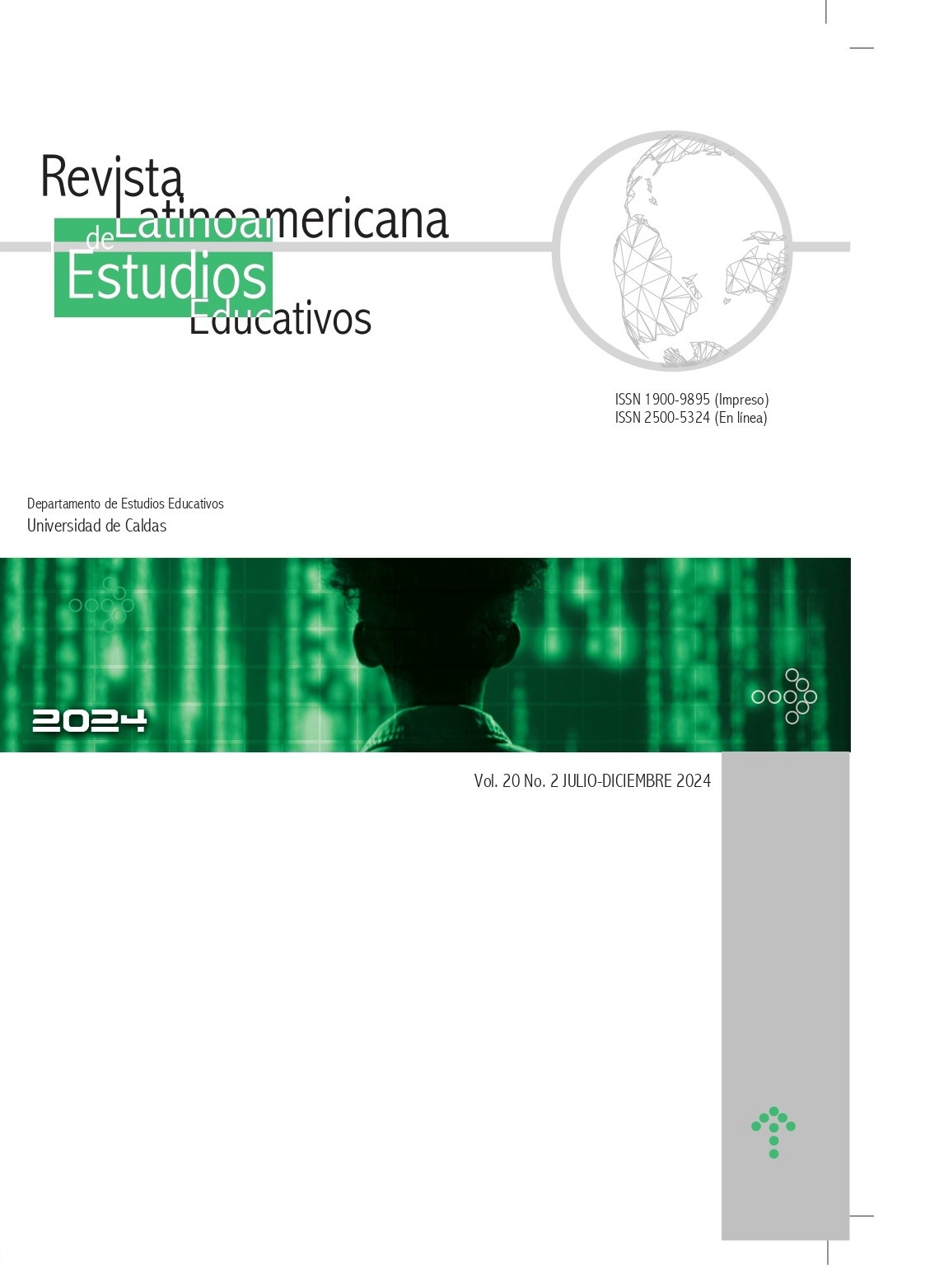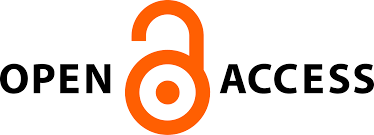Authors
Abstract
Emerging technologies are transforming teaching and learning processes, generating new applications at various educational levels. This study aims to examine the current state of artificial intelligence (AI) in basic education globally, analyzing its benefits, challenges and implementation trends. A systematic mapping methodology of Petersen et al. (2015) and Kitchenham and Charters (2007) was used. The literature search was conducted between December 15 and 30, 2024 in the academic databases Scopus, ScienceDirect and SpringerLink, using the selection process of Roehrs et al. (2017), where the collected data were analyzed using VOSviewer software and Microsoft Excel. The results indicate that AI has key implications in educational innovation in basic
education and in teaching and learning processes. Its benefits include personalized feedback, content adaptation and administrative efficiency to improve educational quality. Despite this, its adoption requires ethical guidelines to guide its responsible use. There is a growing trend of publications that report on the integration of AI-based tools in basic education (Chiu and Chai, 2020; Balaban and Ruzic, 2024; Falebita and Kok, 2024), covering diverse activities of educational management.
References
Balaban, I., & Ruzic, I. (2024). The use of social robots as teaching assistants in schools: implications for research and practice. Revista de Educación a Distancia (RED), 24(78). https://revistas.um.es/red/article/view/600771/363331
Balabdaoui, F., Dittmann, N., Grosse, H. (2024). A survey on students use of AI at a technical university. Discov Educ 3, 51. https://link.springer.com/article/10.1007/s44217-024-00136-4
Bautista, P., Sánchez, E., Orejudo, S., & Cano, J. (2024). Training pre-service teachers to deal with cyberbullying: Collective intelligence as a mode of learning. Computers & Education, 220, 105123. https://doi.org/10.1016/j.compedu.2024.105123
Baskota, P., Poudel, T. (2024). Artificial intelligence and computer-mediated communication: the text analysis and undergrads class observation. Discov Educ 3, 131. https://link.springer.com/article/10.1007/s44217-024-00187-7
Bolaño, M., & Duarte, N. (2024). Una revisión sistemática del uso de la inteligencia artificial en la educación. Revista Colombiana de Cirugía, 39(1), 51-63. https://www.revistacirugia.org/index.php/cirugia/article/view/2365
Castillo, M. (2023). Impacto de la inteligencia artificial en el proceso de enseñanza y aprendizaje en la educación secundaria: Impact of artificial intelligence on the teaching and learning process in secondary education. LATAM Revista Latinoamericana de Ciencias Sociales y Humanidades, 4(6), 515-530. http://latam.redilat.org/index.php/lt/article/view/1459
Chan, C., Lee, K. (2023). The AI generation gap: Are Gen Z students more interested in adopting generative AI such as ChatGPT in teaching and learning than their Gen Xand millennial generation teachers? Smart Learn. Environ. 10, 60. https://link.springer.com/article/10.1186/s40561-023-00269-3
Chen, L., & Lin, Z. (2020). Artificial intelligence in education: A review. Ieee Access, 8,75264-75278. https://ieeexplore.ieee.org/abstract/document/9069875/
Chiu, T. K., & Chai, C. S. (2020). Sustainable curriculum planning for artificial intelligence education: A self-determination theory perspective. Sustainability, 12(14), 5568.https://doi.org/10.3390/su12145568
Crompton, H., Jones, M. V., & Burke, D. (2024). Affordances and challenges of artificial intelligence in K-12 education: A systematic review. Journal of Research on Technology in Education, 56(3), 248-268. https://www.tandfonline.com/doi/abs/10.1080/15391523.2022.2121344
Crovetto, A. (2020). ¿Quieres que te enseñe Siri?: Inteligencia Artificial en la educación. Instituto De Estudios Transhumanistas, 3(1). https://doi.org/10.52749/iet.v3i1.15
Dai, C. P., & Ke, F. (2022). Educational applications of artificial intelligence in simulationbased learning: A systematic mapping review. Computers and Education:Artificial Intelligence, 3, 100087. https://www.sciencedirect.com/science/article/pii/
S2666920X2200042X
Diaz et al. (2021). Inteligencia artificial aplicada al sector educativo. Revista Venezolana de Gerencia, 26(96), 1189-1200. https://doi.org/10.52080/rvgluz.26.96.12
Echeverría et al. (2023). Recursos digitales con Inteligencia Artificial para mejorar el Aprendizaje de los Estudiantes de Primaria. Ciencia Latina Revista Científica Multidisciplinar, 7(4), 1463-1481. https://n9.cl/k1pkod
Falebita, O.S., Kok, P.J. Strategic goals for artificial intelligence integration among STEM academics and undergraduates in African higher education: a systematic review. Discov Educ 3, 151 (2024). https://link.springer.com/article/10.1007/s44217-024-00252-1
Feldman-Maggor, Y., Cerratto-Pargman, T., & Viberg, O. (2024, September). Seeing the forest from the trees: Unveiling the landscape of generative AI for education through six evaluation dimensions. In European Conference on Technology Enhanced Learning (pp. 99-105). Cham: Springer Nature Switzerland. https://link.springer.com/chapter/10.1007/978-3-031-72312-4_12
Flores et al. (2022). Los nuevos paradigmas de la Inteligencia artificial aplicados a la educación. Revista de Investigación Académica sin Frontera, 38. https://dialnet.unirioja.es/servlet/articulo?codigo=8728008
Gangotena et al. (2023). Recursos digitales con Inteligencia Artificial para mejorar el Aprendizaje de los Estudiantes de Primaria. Ciencia Latina Revista Científica Multidisciplinar, 7(4), 1463-1481. https://doi.org/10.37811/cl_rcm.v7i4.6967
García, J., Alor, L., y Cisneros, Y. (2023). Percepción de los tutores virtuales sobre el impacto de la inteligencia artificial en la educación universitaria. Company Games & Business Simulation Academic Journal, 3(1), 49-58.http://www.uajournals.com/ojs/ index.php/businesssimulationjournal/article/view/1439
García et al. (2020). La inteligencia artificial en la educación. Dominio de las Ciencias. 6(3). 648-666. https://dialnet.unirioja.es/servlet/articulo?codigo=8231632
Giraldo, M. (2017). Descubrimiento de patrones en interacciones entre estudiantes y plataformas virtuales de educación mediante el uso de analíticas de aprendizaje. Tesis de Maestría, Universidad Nacional de Colombia. https://repositorio.unal.edu.co/handle/unal/59165
Gocen, A., & Aydemir, F. (2020). Artificial intelligence in education and schools. Research on Education and Media, 12(1), 13-21. https://sciendo.com/article/10.2478/rem-2020-0003?content-tab=abstract
Golic, Z. (2019). Finance and artificial intelligence: The fifth industrial revolution and its impact on the financial sector. Zbornik radova Ekonomskog fakulteta u Istočnom Sarajevu, (19), pp. 67–81. https://www.ceeol.com/search/article-detail?id=828906
Hernández, R., & Mendoza, C. (2020). Metodología de la investigación: las rutas cuantitativa, cualitativa y mixta. https://www.academia.edu/download/64591365/ Metodolog%C3%ADvestigaci%C3%B3n.%20Rutas%20cuantitativa,%20
cualitativa%20y%20mixta.pdf
Hmoud, M., Swaity, H., Anjass, E., & Aguaded-Ramírez, E. M. (2024). Rubric Development and Validation for Assessing Tasks Solving via AI Chatbots. Electronic Journal of e-Learning, 22(6), 01-17. https://doi.org/10.34190/ejel.22.6.3292
Kanont, K., Pingmuang, P., Simasathien, T., Wisnuwong, S., Wiwatsiripong, B., Poonpirome, K., ... & Khlaisang, J. (2024). Generative-AI, a Learning Assistant? Factors Influencing Higher-Ed Students Technology Acceptance. Electronic Journal of e-Learning, 22(6),18-33. https://doi.org/10.34190/ejel.22.6.3196
Karsenti, T. (2019). Artificial intelligence in education: the urgent need to prepare teachers for tomorrows schools. Formation et profession, 27(1), pp. 112–116. http://Doi:10.18162/fp.2019.a166
Kitchenham, B., & Charters, S. (2007). Guidelines for performing systematic literature reviews in software engineering.Technical Report Technical report, EBSE Technical Report EBSE-2007–01.
Kurshumova, D. (2024). A snapshot of Bulgarian school teachers familiarity with use of, and opinions on artificial intelligence at the threshold of its incorporation into the educational process. Discov Educ 3, 138. https://link.springer.com/article/10.1007/s44217-024-00225-4
Kavitha, K., & Joshith, V. P. (2024). Pedagogical Incorporation of Artificial Intelligence in K-12 Science Education: A Decadal Bibliometric Mapping and Systematic Literature Review (2013-2023). Journal of Pedagogical Research, 8(4), 437-465. https://eric.ed.gov/?id=EJ1456458
Li, H., & Wang, H. (2020). Research on the application of artificial intelligence in education.In 2020 15th international conference on Computer Science & Education (ICCSE) (pp.589-591). IEEE. https://ieeexplore.ieee.org/abstract/document/9201743/
Martin, F., Zhuang, M., & Schaefer, D. (2024). Systematic review of research on artificial intelligence in K-12 education (2017–2022). Computers and Education: Artificial Intelligence, 6, 100195. https://www.sciencedirect.com/science/article/pii/S2666920X23000747
Mohammed P.S., & Watson E. N. (2019). Towards inclusive education in the age of artificial intelligence: perspectives, challenges, and opportunities. In: Knox J., Wang Y., Gallagher M. (eds) Artificial Intelligence and Inclusive Education. Perspectives on Rethinking and Reforming Education. Singapore: Springer. https://doi.org/10.1007/978-981-13-8161-4_2
Mou, X. (2019). Artificial intelligence: investment trends and selected industry uses. EMCompass; No. 71. Washington, D.C.: World Bank Group. https://documents1.worldbank.org/curated/zh/617511573040599056/pdf/Artificial-Intelligence-Investment-Trends-and-Selected-Industry-Uses.pdf
Netland, T., von Dzengelevski, O., Tesch, K., & Kwasnitschka, D. (2024). Comparing humanmade and AI-generated teaching videos: An experimental study on learning effects.Computers & Education, 105164. https://doi.org/10.1016/j.compedu.2024.105164
Ng, A. (2017). Artificial intelligence is the new electricity. Speech presented at Stanford MSx Future Forum in California, Stanford. https://www.youtube.com/watch?v=21EiKfQYZXc
Petersen, K., Vakkalanka, S., & Kuzniarz, L. (2015). Guidelines for conducting systematic mapping studies in software engineering: An update. Information and Software Technology, 64, 1–18. https://www.sciencedirect.com/science/article/pii/S0950584915000646
PwC. (2019). ¿Sizing the prize Whats the real value of AI for your business and how can you capitalise? Retrieved from https://www.pwc.com/gx/en/issues/analytics/assets/pwc-ai-analysis-sizing-the-prize-report.pdf.
Ramírez, G. (2024). La Inteligencia Artificial (IA) en el estudio de las Ciencias Naturales: Oportunidades y Desafíos. Revista InveCom/ISSN en línea: 2739-0063, 4(1), 1-13.http://www.revistainvecom.org/index.php/invecom/article/view/3027
Rodríguez et al. (2023). La Implementación de la Inteligencia Artificial en la Educación: Análisis Sistemático. Domino de las Ciencias, 9(3), 2162-2178. https://dominiodelasciencias.com/ojs/index.php/es/article/view/3548
Roehrs, A., Da Costa, C. A., da Rosa Righi, R., & De Oliveira, K. S. F. (2017). Personal health records: a systematic literature review. Journal of medical Internet research, 19(1),e5876. https://www.jmir.org/2017/1/e13/We
Romero, JM., Ramírez, MS., Buenestado, M. (2023). Use of ChatGPT at University as a Tool for Complex Thinking: Students Perceived Usefulness. J. New Approaches Educ.Res. 12, 323–339. https://link.springer.com/article/10.7821/naer.2023.7.1458
Rubia, F. A. (2024). Inteligencia artificial en la educación. Una guía práctica para profesores en la era digital. Instituto Latinoamericano de Desarrollo Profesional Docente Buenos Aires, 2024. In Forum Aragón: revista digital de FEAE-Aragón sobre organización y gestión educativa (No. 41, pp. 69-69). Forum Europe de Administraciones de Educación-Aragón. https://dialnet.unirioja.es/servlet/articulo?codigo=9412057
Sperling, K., Stenberg, C. J., McGrath, C., Åkerfeldt, A., Heintz, F., & Stenliden, L. (2024). In search of artificial intelligence (AI) literacy in Teacher Education: A scoping review. Computers and Education Open, 100169. https://www.sciencedirect.com/science/article/pii/S2666557324000107
Su, J., & Yang, W. (2022). Artificial intelligence in early childhood education: A scoping review. Computers and Education: Artificial Intelligence, 3, 100049. https://www.sciencedirect.com/science/article/pii/S2666920X22000042
Timms, M. J. (2016). Letting artificial intelligence in education out of the box: educational cobots and smart classrooms. International Journal of Artificial Intelligence in Education, 26(2), pp. 701–712. https://link.springer.com/article/10.1007/s40593-016-0095-y
Uddin, S. J., Albert, A., Ovid, A., & Alsharef, A. (2023). Leveraging ChatGPT to aid construction hazard recognition and support safety education and training. Sustainability, 15(9), 7121. https://doi.org/10.3390/su15097121}
Wambsganss, T., Janson, A., & Leimeister, J. M. (2022). Enhancing argumentative writing with automated feedback and social comparison nudging. Computers & Education, 191, 104644. https://doi.org/10.1016/j.compedu.2022.104644
Wang, S., Wang, F., Zhu, Z., Wang, J., Tran, T., & Du, Z. (2024). Artificial intelligence in education: A systematic literature review. Expert Systems with Applications, 252, 124167. https://www.sciencedirect.com/science/article/pii/S0957417424010339
Wartman, S. A., & Combs, C. D. (2018). Medical education must move from the information age to the age of artificial intelligence. Academic Medicine, 93(8), 1107-1109. https://journals.lww.com/academicmedicine/fulltext/2018/08000/medical_education_must_move_from_the_information.15.aspx
Wiboolyasarin, W., Wiboolyasarin, K., Tiranant, P. (2024). Designing chatbots in language classrooms: an empirical investigation from user learning experience. Smart Learn. Environ. 11, 32. https://link.springer.com/article/10.1186/s40561-024-00319-4

 PDF (Español)
PDF (Español)
 FLIP
FLIP
























